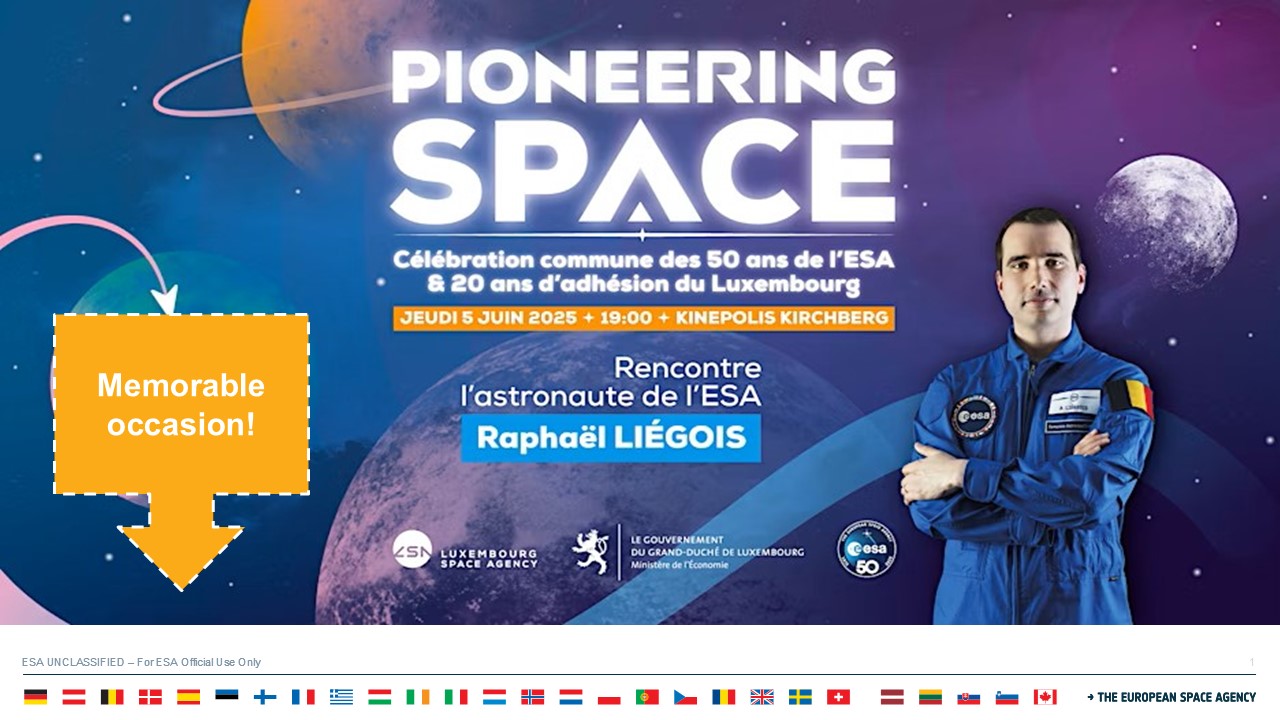The development of a new product or service via Space very often involves opening up to related fields of activity and to “fields of possibility”.
Man's conquest of space is costly, but in relative terms, and in particular through the transfer of knowledge and technology, it serves our populations very well: we benefit from this every day. We listened to Raphaël Liégeois who came to Luxembourg on June 5, 2025 to talk about his job as an astronaut and, above all, his training to become an astronaut. At the express invitation of the LSA and the Ministry of the Economy, Raphaël Liégeois is likely to fly next year. He talked to us about his trials and tribulations and the lessons he learned on “Space matters” in Houston and Cologne, and in the various ESA centres of expertise. He is a gifted and modest man, open to sharing his current experience, and who can be said to be a fine human being! The six European astronaut candidates for 2023, all from different scientific backgrounds, seem to originate from the finest of vintages!
At CREACTION, for and with our clients, we work on the accelerated and controlled optimization-validation of new, complete and qualified concepts. This applies both to the transfer of space technologies to terrestrial applications and to the development of new technological approaches on Earth with potential for Space. These two approaches have the potential to lead to the effective launch of new competitive products for the European Space Agency and citizens at large.
Several tools are in place, but beyond the financial support of ESA and LSA, CREACTION (like others in the Brokers network) uses the resources of the ESA technological competence centers. In particular, the EAC in Cologne, “home” to ESA’s astronaut corps! It is the European centre of excellence for the selection, training and support of astronauts, where the focus is on the skills and knowledge they need to fly to the International Space Station (ISS) today while preparing for an exciting future of exploration beyond low Earth orbit. This suits us well, as we need the latest technologies applied to new transfer concepts.
As a result, the areas of human activity in space are extremely varied. Let's take a little-known sector: astronaut nutrition. CREACTION has already called on EAC's expertise in this field: for example, to create new ways of dosing and distributing personalized organic food for personnel at industrial sites. Similarly, with NASA, we have studied the conservation packaging of biodegradable or pre-cooked products based on the conservation of food for space exploration. For the record, the reverse can also happen! Some time ago, ESA and the Technology Transfer Department wanted to offer their astronauts a memorable New Year's Eve celebration: a special menu was prepared by a top French chef, accompanied by prestigious wines, all freeze-dried and gift-wrapped. A wonderful celebration for the astronauts, whose daily work is on a par with that of top sportsmen and women.
Beyond food and survival systems in extreme environments, the EAC provides us with interesting scientific resources. This year we are supporting the feasibility of new concepts linked to the healthcare sector and harsh environments (magmas and solar radiation). And if space weather and its three-day forecasts are now increasingly used and known (see our last TT article on the subject), here we are helping more specifically the development and monitoring of tests for new drugs in the immune field for astronauts. This is relevant not just to astronauts' own missions but also to future exploration missions, with additional spin-off benefits for those working on earth in a nuclear environment both in civil and industrial contexts.
CREACTION was also involved in the development and validation of new, lighter oxygen masks, the special feature of which was to integrate O2/CO2 exchange analysis systems directly into the mask for live monitoring. Here, both terrestrial technologies for fine analysis of O2/CO2 gas exchanges and their residues, and the brilliant plasma study sensors developed by Dr. Messerschmitt (fourth generation of the well-known family) have enabled a significant breakthrough in the cardio-respiratory instrumentation market. A real success story!
The development of a new product or service via Space very often involves opening up to related fields of activity and to “fields of possibility”. Here too, we need to be able to push back the boundaries! Technological added-value, and therefore industrial and financial results, depends on customer-market advantages. Space transfer is a great access route, so seize it!



